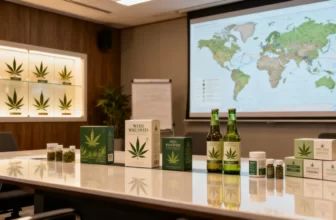Recent studies have highlighted a significant increase in marijuana use among older adults in the United States. This trend has been particularly notable for those seeking pain relief, better sleep, improved mental health, and general relaxation. Let’s dive into the main findings and implications of this growing phenomenon.
Increasing popularity of cannabis use among older adults
Marijuana use among Americans aged 50 and above has nearly doubled over the past three years. Current statistics indicate that more than one in five people in this age group have used cannabis at least once in the last year. This represents a significant uptick from previous years, with usage rates expected to rise further as more states move towards legalization.
Specifically, 81% of older users consume marijuana to relax, while 68% use it as a sleep aid. Another 64% enjoy its effects simply for the pleasure it provides. Additionally, 63% seek pain relief through cannabis, and 53% use it to manage their mental health. The younger segment within this demographic, particularly those between ages 50 and 64, show higher monthly usage rates, especially among individuals in poor health or from low-income households.
Regional differences in cannabis consumption
The University of Michigan’s National Poll on Healthy Aging observed notable regional variations. For instance, in Michigan alone, 27% reported having used marijuana in the past year, with weekly and daily usage rates standing at 14% and 9%, respectively. These figures were derived from surveys involving 1,079 older Michiganders and 3,012 non-Michigan adults.
The data underscores the necessity for enhanced education about cannabis, particularly as THC-containing products become more prevalent. With cannabis now legal in various forms across 38 states, including pending legislation, users must be informed about potential risks and safe consumption practices.
Healthcare providers and cannabis discussions
A significant outcome of the study revealed that more than half of regular cannabis users discuss their usage with healthcare providers. However, this also means nearly half do not, potentially overlooking crucial conversations about drug interactions and other health considerations. Many believe modern marijuana is stronger than what was available in earlier decades, yet some may not realize the full extent of increased THC levels.
Experts stress the importance of these discussions. Offering information regarding one’s cannabis use can help identify possible risky drug interactions and signs of problematic use. Both medical professionals and patients need to engage openly about cannabis, considering the complex interplay with prescription medications and over-the-counter drugs.
Perceptions and realities of cannabis addiction
While around 72% of surveyed individuals acknowledge the addictive potential of cannabis, there remains a substantial portion who are either skeptical or unaware. This highlights a gap in education and awareness. Given the evolving landscape of cannabis legalization, more scientific research is needed to establish safe usage guidelines and inform public health policies.
Healthcare professionals, such as Dr. Jeffrey Kullgren from the Veterans Affairs Ann Arbor Healthcare System, emphasize the critical need for open dialogue about cannabis use. Such conversations can mitigate risks and optimize the benefits for those using cannabis for various health concerns.
The future of cannabis regulation and research
As federal reclassification of cannabis appears imminent, moving it to Schedule III under the Controlled Substances Act could pave the way for further research and better regulatory frameworks. This shift might facilitate broader acceptance and a more nuanced understanding of cannabis’ benefits and drawbacks.
The ongoing legalization efforts and changing societal attitudes suggest that cannabis use among older adults will continue to grow. Consequently, ensuring widespread access to accurate information and professional guidance will be vital in navigating this expanding landscape. Researchers, healthcare providers, and policymakers must collaborate to develop comprehensive education programs and clear guidelines tailored to the needs of older cannabis consumers.
The influx of older adults turning to marijuana presents both opportunities and challenges. Balancing the therapeutic potential with the necessity for informed, responsible use will be crucial in shaping the future of cannabis consumption in this demographic.





